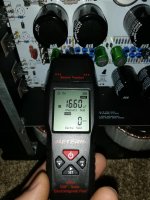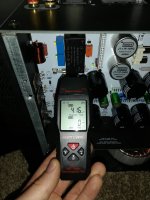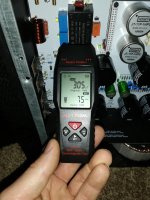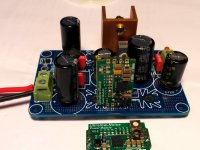These folks now claim to have "Best 5V Linear" for the Raspberry Pi based on a new Ti chip : Mambo Power Supply for Raspberry Pi boards - Collybia.com
"With the new ultra noise Ti chip, which has the capability for 5V – 3A output (for the first time), we eliminate every noise from power field, in addition.
Αnd we are sure that the music community has been waiting for it for many years"
It's so outstanding that there's ZERO stock, no reviews, just one picture of an aluminium case from the top, 4.4 μVRMS output noise voltage and NO MENTION in the News section of the site. I can see here the Collybia's ploy to get some traffic to their site with the hope for an incresse of sales (not in the PSUs area for sure)...
Here is mine, also 4uV rms, set to regulate at 5V ready for my TDA1387 Matt Garman dac build. Fed from a 19V router smps. No fancy aluminium case (yet), cost is less than $30, including a DC DC step down converter. Lots of stock available. You can get boards here:
GB for Simple Cap-Mx Regulated Low-Noise PSU
GB for Simple Cap-Mx Regulated Low-Noise PSU
Attachments
Nice work Twocents! I see you managed to fit the eBay TPS7A LDO regulator board onto it. I see these other ones with heatsink and pins already attached. I think the extra pins are optional sense pins and can be removed for 78xx format TO220 style 3 pins.
TPS7A4701 Low Noise RF LDO Regulator Power Supply Module 1.5V-34V 3.3V 5V 12V 1A 699923682709 | eBay
These are about $12 ea.
TPS7A4701 Low Noise RF LDO Regulator Power Supply Module 1.5V-34V 3.3V 5V 12V 1A 699923682709 | eBay
These are about $12 ea.
Last edited:
Not good. Those are off the shelves smps , with all the EMI/Common Mode noise / Diff noise associated. Furthermore the architecture of those SMPSs is important (Zero valley Sw/full bridge is best , quasi resonant is ok but most are none of the above.)
Any updates on Nirvana? A high quality SMPS would be a good option to power the pi . Have you thought about producing a 5V/15V LPS, it should work well with a Katana v2, that deletes the onboard dc-dc 15v supply. From the other Katana based forums big improvements in sound quality have been achieved by bypassing on board 15v supply. The 2 together would provide the best possible power scheme for Katana to get highest quality output.
Using my EMF and magnetic test meter, the EMF doesn't extend very far from the SMPS, compared to the magnetic fields produced by transformers. The EMF is really nothing more than what you get from the power wires that go through the chassis. The magnetic fields I am working with on my project, using a combination of materials, steel being one, and I will test in conjunction with a sheet of mumetal if necessary. In my project, using a Raspberry Pi, the EMF was very high before I had disabled the on-board WiFi. The SMPS is practically nothing in comparison to the WiFi. I also plan to add another +-15v SMPS for future with no reservations about doing so. I am much more concerned about the magnetic fields because I plan to move my input transformers closer to the power toroids. My requirements are equal or less magnetic flux, more likely less with some steel and possibly mumetal shielding incorporated. EMF is nearly non-existent after disabling WiFi. A good choke filter, some caps, clean regulated down, more caps and your'e good. My system is un-attenuated, the only volume control is the DAC itself and there is but the slightest 60hz sound that you'll try hard to hear with your ear up against the speaker, the amp power supply. Even that will disappear on the final version. Nothing to do with the DAC or input whatsoever.
A good PSU and DAC/source should not have any audible mains buzz/hum even with ear pressed to speaker. Imagine if it were a headphone amp. If you can hear buzz with ear, that’s about 1mV to 1.2mV rms for typical sensitivity speakers. Connect a DVM to your speaker outs and measure AC mV.
It may be a ground loop as SMPS have nice feature of pushing mains band out to 200-400kHz where it is easily and steeply filtered.
It may be a ground loop as SMPS have nice feature of pushing mains band out to 200-400kHz where it is easily and steeply filtered.
One meter reading 0.0 mv range and another .001mv
Both ground plane and power supply will be redesigned for better isolation. It's extremely faint, at the edge of hearing. 60hz. Originally I hadn't intended to use input transformers and now can completely isolate systems now that I am. There will be no way of ground loop. To get an EMF reading, I must put the meter on the smps, while, just now, I left it on more than a foot from my phone and was reading high while my phone accessed the network. Inside my chassis, the meter reading magnetic fields high, not EMF. Even though, I will be isolating better both Pi and amp supplies.



Both ground plane and power supply will be redesigned for better isolation. It's extremely faint, at the edge of hearing. 60hz. Originally I hadn't intended to use input transformers and now can completely isolate systems now that I am. There will be no way of ground loop. To get an EMF reading, I must put the meter on the smps, while, just now, I left it on more than a foot from my phone and was reading high while my phone accessed the network. Inside my chassis, the meter reading magnetic fields high, not EMF. Even though, I will be isolating better both Pi and amp supplies.



Last edited:
Nirvana internal testing is completed.
We are sending for FCC certification our last hurdle.
About noise...we have tested many PSUs (lps , "other low noise smps" normal SMPS). Nirvana is in a class of its own . Differential noise is lower than 500uV, common mode also almost at floor and then we arrive at ground noise. Strangely this is there most SMPSes fail including the so called "ultra low noise SMPS" . We measure 3.6mV of noise vs 1mV with shorted probes on the ground of the quietest SMPS. Nirvana is at 1.10mV on ground. On every test , every noise, Nirvana seems to be better .
We are sending for FCC certification our last hurdle.
About noise...we have tested many PSUs (lps , "other low noise smps" normal SMPS). Nirvana is in a class of its own . Differential noise is lower than 500uV, common mode also almost at floor and then we arrive at ground noise. Strangely this is there most SMPSes fail including the so called "ultra low noise SMPS" . We measure 3.6mV of noise vs 1mV with shorted probes on the ground of the quietest SMPS. Nirvana is at 1.10mV on ground. On every test , every noise, Nirvana seems to be better .
Nice work Twocents! I see you managed to fit the eBay TPS7A LDO regulator board onto it. I see these other ones with heatsink and pins already attached. I think the extra pins are optional sense pins and can be removed for 78xx format TO220 style 3 pins.
TPS7A4701 Low Noise RF LDO Regulator Power Supply Module 1.5V-34V 3.3V 5V 12V 1A 699923682709 | eBay
These are about $12 ea.
I had problems with those kind caused by trimpot. There are few sellers having upgraded version with multi turn trimpots on the boards.
as a last thing , when Nirvana DC is earthed the noise (on Gnd) reduces to a hair of shorted probes . We are including a small SW to chose DC (earthed or floating)
Nirvana internal testing is completed.
We are sending for FCC certification our last hurdle.
About noise...we have tested many PSUs (lps , "other low noise smps" normal SMPS). Nirvana is in a class of its own . Differential noise is lower than 500uV, common mode also almost at floor and then we arrive at ground noise. Strangely this is there most SMPSes fail including the so called "ultra low noise SMPS" . We measure 3.6mV of noise vs 1mV with shorted probes on the ground of the quietest SMPS. Nirvana is at 1.10mV on ground. On every test , every noise, Nirvana seems to be better .
That is good news! I am currently using the iFi ipower on my Digione player which is an audible improvement upon the standard smps(darker background improved lows etc.). Looking forward to getting one or two as soon as you release them for sale (date?) to test them out in my system.
One edit...diff noise on Nirvana is (less) than 500nV (not uV)
When FCC testing will be completed (and passed) we will announce a date and price for both LPS(dual 5V 3A/1.5A) and Nirvana 5V/3A
When FCC testing will be completed (and passed) we will announce a date and price for both LPS(dual 5V 3A/1.5A) and Nirvana 5V/3A
...we will announce a date and price for both LPS(dual 5V 3A/1.5A) and Nirvana 5V/3A
All very interesting. Could turn out that Allo will have power solutions for Katana as good or, possibly even better, than the various diy efforts have shown so far.
...Could turn out that Allo will have power solutions for Katana as good or, possibly even better, than the various diy efforts have shown so far.
🙄
First you need to understand that a manufacturer who designs FCC and CE compliant power supplies must accept compromises (I hope the new devices will also be CE - covers also safety - compliant). These compromises usually impact the maximum achievable performance.
Beside that, manufacturers need to design rather universal devices. That'll also lead to compromises.
DIY efforts in that area in comparison are usually rather dirty hacks.
FCC/CE compliance? Safety? Or even measurements? Nope. You gotta be kidding.
What I see is just a continuous wild swapping of partially very expensive parts and/or boards, leading to a rather coincidental sound impression that matches one or few environments only. These setups usually never leave the "lab" stage. Which is irrelevant since they'll be swapped out in a 2-weekly cycle anyhow.
Nope. Allo won't comply to that.
For sure they'll provide a high quality power supply at a reasonable price tag.
I'm looking forward to that.
*********
The only thing I'm a bit disappointed about is that Allo seems to look at extraordinary low noise levels only. Of course these are relevant. How much relevant on a primary PS is a different question. There'll be tons of filters and regulators further downstream coping with most of the residual 1st power stage noise.
They - as most others - don't seem to look at one of the IMO key factors of a 1st stage audio power supply:
The transient response and transient recovery.
Basically delivering the current as fast as possible and recovering from it as fast as possible.
That's what quite a number of DIY nerds - and that includes me - seem to address by using big low ESR buffers after such a commercial supply.
E.g. Ians quite recent prototype - a super-large supercap-buffer supply (output is not regulated if I recall it correctly) - which he regards as the best supply option he has built so far, IMO points in exactly that direction.
What's IMO missing is the discussion about the subject. There are basically no measurements and related benchmarks I'm aware of. It's usually just all about noise.
I'd really like to see Allo taking the first step on that subject.
Last edited:
Basically delivering the current as fast as possible and recovering from it as fast as
For me, an important aspect of a low noise PSU is the ability to slowly turn on with a ramp up voltage and gentle ramp down. This is a PSU and not an audio amp output stage. The soft start allows SMPS to cope with massive in rush that loading downstream caps would normally cause - usually leading to auto shutoff on the SMPS. A capacitance multiplier in series right after the SMPS but before the downstream filters and regulators gives this functionality. It also prevents turn on/off pop noises from speakers or headphones. Generally reduces transient damage that often occurs when switching equipment on and off.
The simple low noise cap Mx PSU that I mentioned earlier does this - member Twocents has beta tested it on a DAC and RPi and his subjective impression is that it is quieter than other supplies he has used.
Here is version with TPS7A4xx 4uV rms voltage regulator. You can use your choice of regulator or bypass and just use cap Mx which cuts ripple by 50dB and has a soft start feature (approx 10 seconds to full voltage).
Production boards are ENIG finish and have a green solder mask - not massive vias for double plane low impedance current paths. Uses standard screw terminals or can be wired for flying leads.
Last edited:
I use a large power pack and high output smps of the cheaper type. To me this removes doubt as the smps is switched off when playing music. I mention this as it is an easy solution with some reference qualities. I have a 10uf high grade capacitor at any device to assist. I haven't measured the noise performance. Any thoughts?
It's usually just all about noise.
Understood. However, I prefer to give Allo the benefit of doubt until proven otherwise. Be nice to do some performance comparisons and see how the new Allo supplies affect Katana sound quality before forming an opinion one way or another.
After all, Katana so far appears to be the best sounding hat dac available. With good enough power supplies its SQ can compete well with dacs costing far more. Personally, don't know of clearly better sounding commercial dacs costing less than around $1,800 - $2,200.
With power supplies in particular, Allo has benefit of some feedback from the diy community regarding power supplies that bring the best SQ out of Katana. If they do their own listening tests in addition to measurements, a lesson they said they learned from the early Katana experience, then it doesn't seem unreasonable to be hopefully optimistic.
- Home
- Amplifiers
- Power Supplies
- Best 5V SMPS ?
